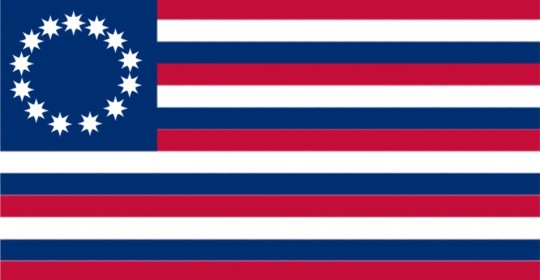

Description of First American Flag Above:
The Franklin & Adams United States Flags – October 9, 1778
The Genesis of the Early American Flag is something of a great mystery. Things were happening and all kinds of ‘Rebel’ Flags went a flying. It’s interesting to note Benjamin Franklin and John Adams’ description of the US Flag to a foreign dignitary. The letter describes the “Flag of the United States of America” and is dated to October 9, 1778.
(Dear King of the Two Sicilies)
“It is with pleasure that we acquaint Your Excellency that the flag of the United States of America consists of 13 Stripes, alternately Red, White, and Blue; a Small Square in the upper angle, next to the Flag staff, is a Blue Field, with 13 White Stars, denoting a New Constellation. Some of the States have Vessels of War distinct from those of the United States…but the Flag of the United States, ordained by Congress, is the 13 Stripes and 13 Stars above described.”
(Signed) “B. Franklin” “John Adams”
Historical References and Credits
1. Fort Stanwyk, August 1777
2. Fort Mifflin, October 1777
3. Captured HMS Serapis September 23,, 1779.
5. Surrender at Yorktown 1781 by John Trumbull (painted 1787)
-Maddish, The Voice of Vexillology, Flags & Heraldry. Flag Day 2012 – The original Red, White and Blue. The Franklin & Adams Flag. – October 9, 1778. Second Picture, -Mort Kunstler’s, General George Washington, accepting British surrender at Yorktown.

Description of 2nd American Flag below:
This is the flag used on board the captured British ship “Serapis” on September 23, 1779, Captain John Paul Jones. This ship was captured following the famous sea battle between the “Serapis” and the “Bonhomme Richard” in which the latter’s flag staff was blown away; the British Captain asked if Jones had struck his colors; and Jones replied “Struck, Sir? I Have Not Yet Begun To Fight!” The “Bonhomme Richard” was so badly damaged that it sank with its colors flying. After putting into the Dutch port of Texel for refitting, the British authorities in the Netherlands demanded Jones be arrested as a pirate since he flew no known flag. The Dutch replied that they would consult their archives. Sometime between then and a few days later when they replied to the British that they had evidence in their files that the flag used on the “Serapis” was a recognized flag and that Jones would be allowed to refit, a painting of this flag (and that of the Alliance) was made. Besides the unconventional use of blue stripes as well as white and red, if you examine the painting closely you will see there are 12 eight pointed stars and one seven pointed star on the flag. It is also nearly square.
-Dave Martucci, 6 December 1997
Franklin, Adams and the Serapis Flag
In a letter dated October 9, 1778, Benjamin Franklin and John Adams described this flag to the Ambassador of the King of the Two Sicilies. It is the flag later known as the “Serapis” flag. While Benjamin Franklin was the U.S. ambassador to Paris in 1777, John Paul Jones was creating so much havoc on the high seas with his raids on the British Merchant Marine and coastal villages that the Admiralty issued orders to have him hung as a pirate if he could be captured. The reason given for the order was a legalistic one — he did not fly the flag of any recognized nation. While Ambassador Franklin pondered possible solutions to this problem, the Dutch Ambassador, acting for his government, asked for a description of the United States Flag. As far as Mr. Franklin knew, no national flag existed. Nevertheless, he gave his visitor a description of what we now call the “Franklin or Serapis Flag.” This description was sent to the Dutch Fleet, along with the orders that it be recognized on the high seas. Shortly afterwards, the Ambassador of the two Sicily’s came to call, making the same request. He also received a description of the flag, and forwarded similar orders to his country’s fleet. Mr. Franklin, then apparently, had the flag made and sent to Jones so that it could be flown at his ships’ masthead. By doing this, he could avoid being treated as a pirate by other countries. Thus the United States, through its Navy, was first given official recognition by foreign countries. Meanwhile a ship from the United States was on its way to Paris with a notice that a “Resolve” of Congress of June 14, 1777, had adopted the now familiar “Stars and Stripes.” No one knows who designed or made this flag for Mr. Franklin. The “Franklin Flag” that was given for foreign recognition before the first national flag was adopted was similar to the one we know today. Its colors are red, white and blue, and it had thirteen stripes and thirteen white eight-pointed stars on a blue background.
-Blas Delgado Ortiz, 27 July 2001
Serapis Flag (U.S.), Historical. By Rick Wyatt, January 1-21-2006, https://www.crwflags.com/FOTW/FLAGS/us-serap.html
























